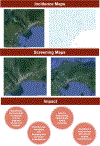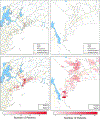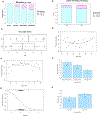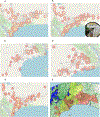Building Programs to Eradicate Toxoplasmosis Part III: Epidemiology and Risk Factors
- PMID: 37744780
- PMCID: PMC10516319
- DOI: 10.1007/s40124-022-00265-0
Building Programs to Eradicate Toxoplasmosis Part III: Epidemiology and Risk Factors
Abstract
Purpose of review: Review comprehensive data on rates of toxoplasmosis in Panama and Colombia.
Recent findings: Samples and data sets from Panama and Colombia, that facilitated estimates regarding seroprevalence of antibodies to Toxoplasma and risk factors, were reviewed.
Summary: Screening maps, seroprevalence maps, and risk factor mathematical models were devised based on these data. Studies in Ciudad de Panamá estimated seroprevalence at between 22 and 44%. Consistent relationships were found between higher prevalence rates and factors such as poverty and proximity to water sources. Prenatal screening rates for anti-Toxoplasma antibodies were variable, despite existence of a screening law. Heat maps showed a correlation between proximity to bodies of water and overall Toxoplasma seroprevalence. Spatial epidemiological maps and mathematical models identify specific regions that could most benefit from comprehensive, preventive healthcare campaigns related to congenital toxoplasmosis and Toxoplasma infection.
Keywords: Incidence; Prevalence; Risk factors; Screening; Spatial epidemiology; Toxoplasma; Toxoplasmosis.
Conflict of interest statement
Declarations Conflict of Interest The authors declare no competing interests.
Figures







References
-
-
McLeod R, Lykins J, Noble AG, Rabiah P, Swisher C, Heydemann P, McLone D, Frim D, Withers S, Clouser F, Boyer K. Management of congenital toxoplasmosis. Curr Ped Rep. 2014;2(3):166–94.
Describes presentation of congenital toxoplasmosis and approach to management of the disease in the United States, including definition of known risk factors, epidemiology, and care.
-
-
-
Sousa OE, Saenz RE, Frenkel JK. Toxoplasmosis in Panama: a 10-year study. Am J Trop Med Hyg. 1988;38(2):315–22.
Provides an early description of epidemiology of Toxoplasma infection in Panama.
-
-
- Pappas G, Roussos N, Falagas ME. Toxoplasmosis snapshots: global status of Toxoplasma gondii seroprevalence and implications for pregnancy and congenital toxoplasmosis. Int J for Parasitol. 2009;39:1385–94. - PubMed
Grants and funding
LinkOut - more resources
Full Text Sources
Research Materials
